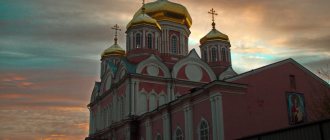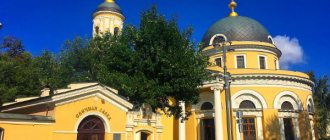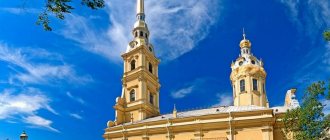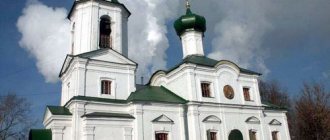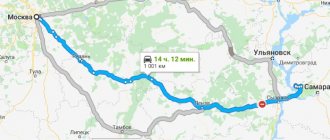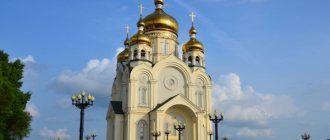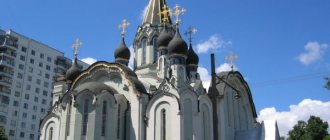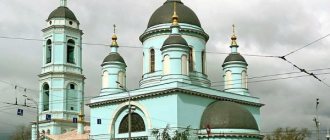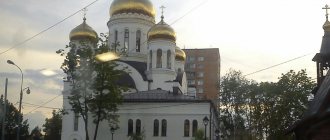Mir
Russia Moscow Church of Peter and Paul in Lefortovo (Moscow) Map is loading...
{"format":"leaflet","minzoom":false,"maxzoom":false,"limit":50,"offset":0,"link":"all","sort":[""], "order":[],"headers":"show","mainlabel":"","intro":"","outro":"","searchlabel":"\u2026 \u0441\u043b\u0435\ u0434\u0443\u044e\u0449\u0438\u0435 \u0440\u0435\u0437\u0443\u043b\u044c\u0442\u0430\u0442\u044b","default":"","import-annotation":false,"width ":"auto","height":"350px","centre":{"text":"","title":"""link":"""lat":55.76533299999999826468410901725292205810546875,"lon": 37.70011099999999970577846397645771503448486328125,"icon":""},"title":"","label":"","icon":"","lines":[],"polygons":[],"circles":[ ],"rectangles":[],"copycoords":false,"static":false,"zoom":8,"defzoom":14,"layers":["OpenStreetMap"],"image layers":[] ,"overlays":[],"resizable":false,"fullscreen":true,"scrollwheelzoom":true,"cluster":false,"clustermaxzoom":9,"clusterzoomonclick":true,"clustermaxradius":80, "clusterspiderfy":true,"geojson":"","clicktarget":"","showtitle":true,"hidenamespace":false,"template":"","userparam":"","activeicon": "","pagelabel":false,"ajaxcoordproperty":"","ajaxquery":"","locations":[{"text":"\u003Cb\u003E\u003Ca href=\"/palomnik/%D0% A5%D1%80%D0%B0%D0%BC_%D0%9F%D0%B5%D1%82%D1%80%D0%B0_%D0%B8_%D0%9F%D0%B0%D0%B2% D0%BB%D0%B0_%D0%B2_%D0%9B%D0%B5%D1%84%D0%BE%D1%80%D1%82%D0%BE%D0%B2%D0%BE_(%D0 %9C%D0%BE%D1%81%D0%BA%D0%B2%D0%B0)\» title=\»\u0425\u0440\u0430\u043c \u041f\u0435\u0442\u0440\u0430 \u0438 \ u041f\u0430\u0432\u043b\u0430 \u0432 \u041b\u0435\u0444\u043e\u0440\u0442\u043e\u0432\u043e (\u041c\u043e\u0441\u043a\u0432\u 0430)\»\u003E\u0425\ u0440\u0430\u043c \u041f\u0435\u0442\u0440\u0430 \u0438 \u041f\u0430\u0432\u043b\u0430 \u0432 \u041b\u0435\u0444\u043e\u0440 \u0442\u043e\u0432\u043e (\u041c \u043e\u0441\u043a\u0432\u0430)\u003C/a\u003E\u003C/b\u003E\u003Chr /\u003E\u003Ca href=\"/palomnik/%D0%A1%D0%B2%D0%BE% D0%B9%D1%81%D1%82%D0%B2%D0%BE:%D0%90%D0%BD%D0%BD%D0%BE%D1%82%D0%B0%D1%86%D0 %B8%D1%8F\" title=\"\u0421\u0432\u043e\u0439\u0441\u0442\u0432\u043e:\u0410\u043d\u043d\u043e\u0442\u0430\u0446\u0438\u044f\"\ u003E\u0410\u043d\u043d\u043e\u0442\u0430\u0446\u0438\u044f\u003C/a\u003E: "'\u0425\u0440\u0430\u043c \u041f\u0435\u0442\u04 40\u0430\u0438\u041f \u0430\u0432\u043b\u0430 \u0432 \u041b\u0435\u0444\u043e\u0440\u0442\u043e\u0432\u0435"' (\u041f\u0435\u0442\u0440\u043e\u04 3f\u0430\u0432\u043b\ u043e\u0432\u0441\u043a\u0430\u044f \u0446\u0435\u0440\u043a\u043e\u0432\u044c) \u2014 \u043f\u0440\u0430\u0432\u043e\u0441\ u043b\u0430\u0432\u043d\u044b \u0439 \u0445\u0440\u0430\u043c \u0432 \u041b\u0435\u0444\u043e\u0440\u0442\u043e\u0432\u0441\u043a\u043e\u043c \u0440\u043 0\u0439\u043e\u043d\u0435\u041c \u043e\u0441\u043a\u0432\u044b. \u041e\u0442\u043d\u043e\u0441\u0438\u0442\u0441\u044f \u043a \u041f\u0435\u0442\u0440\u043e\u043f\u0430\u0432\u043b\u043e\ u0432\u0441\u043a\u043e\u043c \u0443 \u0431\u043b\u0430\u0433\u043e\u0447\u0438\u043d\u0438\u044e \u041c\u043e\u0441\u043a\u043e\u0432\u0441\u043a\u043e\ u0439\u0433\u043e\u0440\u043e \u0434\u0441\u043a\u043e\u0439 \u0435\u043f\u0430\u0440\u0445\u0438\u0438.","title":"\u0425\u0440\u0430\u043c \u041f\u0435\u0442 \u0440\u0430 \u0438\u041f\u0430\u0432\u043b\u0430 \u0432 \u041b\u0435\u0444\u043e\u0440\u0442\u043e\u0432\u043e (\u041c\u043e\u0441\u043 a\u0432\u0430)","link ":"","lat":55.76533299999999826468410901725292205810546875,"lon":37.70011099999999970577846397645771503448486328125,"icon":""}],"image Layers":[]}
55.765311; 37.700307
Russia, Moscow, Soldatskaya street, 4
Moscow
Russia
Phones:
(495) 361-42-15, fax
Church of Peter and Paul in Lefortovo
(Peter and Paul Church) is an Orthodox church in the Lefortovo district of Moscow. Belongs to the Peter and Paul Deanery of the Moscow City Diocese.
History[edit]
The first mention of the temple was in 1613, as the Church of St. Nicholas the Wonderworker. On May 5, 1613, the temple was consecrated in honor of St. Nicholas the Wonderworker with the participation of Tsar Mikhail Fedorovich Romanov. In 1696, the temple was rebuilt on the initiative of Colonel Franz Lefort, and a wooden church was laid for the soldiers of the first Moscow regiment, consecrated in honor of the Supreme Apostles Peter and Paul. In 1711, on the site of a wooden church, a stone temple was built, which has survived to this day.
The main church is in the name of the Supreme Apostles Peter and Paul and there are two chapels: in the name of St. the Apostle Evangelist John the Theologian on the right side, and the second - St. Sergius of Radonezh - on the left. The entire building of the temple is crowned with 5 domes, in addition, one dome above each of the aisles. The bell tower narrows towards the top like a tent with through openings. There are 8 bells on the bell tower. Petersburg Church is one of the few in Moscow where old bells have been preserved. The height of the temple together with the crosses is 18 fathoms or 38 meters. The temple is illuminated in two tiers. From the outside, the temple has three entrances, above the western entrance there is an image of the Kazan Icon of the Mother of God, above the northern entrance there is an icon of the Pechersk Mother of God with St. Anthony and Theodosius, above the South entrance is the Vladimir Icon of the Mother of God. In 1991, a small baptismal church of the Archangel Michael was consecrated, and in 2000, a chapel with the crucifixion of Jesus Christ. The church fence is stone, with iron bars. The entire temple is placed inside the fence. The fence was taken under state protection. On the territory of the temple there is the grave of the former rector of the church - Archpriest Anatoly Novikov and nun A.I. Babkina.
There is conflicting information about the time of construction, consecration and reconstruction of the stone church of Peter and Paul. For example, all sources place its foundation in 1698, when, on Lefort’s initiative, a wooden church was built for the soldiers of his regiment, consecrated in honor of the holy chief apostles. Although on the memorial plaque at the entrance to the temple it is said that it was the Church of the Resurrection of the Word at the Lefortovo Regiment Hospital, and only since 1711 - the Church of the Holy Chief Apostles Peter and Paul.
It was not possible to establish what the latest data is based on. Perhaps there was confusion, and the authors of the memorial plaque identified the first church on the territory of the Hospital (consecrated in 1705 in honor of the Resurrection of the Word) with the wooden church of the Lefortovo regiment at the beginning of its functioning. It is also possible that for some time the wooden regimental church, erected under Lefort, served as a hospital and even had a name, which then passed on to the latter.
During Soviet times, the temple was not closed; the bells were preserved.
In 1991, a small baptismal church of the Archangel Michael was consecrated, in 2000 - a chapel with the crucifixion of Jesus Christ
At the Vvedensky cemetery there is a chapel attached to the temple, converted from the Erlanger family mausoleum.
Architecture
Despite the fact that the founder of the church was a representative of the Protestant Church, it was built in the traditional architectural style of pre-Petrine Russia. The building has the shape of an elongated rectangle. There are five onion-shaped domes above the central part. The only non-traditional detail of the building is the baroque shells that decorate the upper part of the quadrangle. The total height of the temple is 38 meters.
In addition to the central part of the apostles Peter and Paul, there are two chapels in the temple:
- Southern, in honor of John the Evangelist.
- Northern, dedicated to St. Sergius of Radonezh.
The church bell tower is made in a tent style. Above the central entrance there is an icon of the Kazan Mother of God. The northern and southern portals are crowned with images of the Pechersk and Vladimir Mothers of God.
Bell tower of the Church of the Apostles Peter and Paul in Lefortovo
In 1991, a small baptismal temple was built on the territory of the church, consecrated in the name of Archangel Michael. In 2000, a chapel with the crucifixion of Jesus Christ was erected. It contains an ark with a particle of the Life-Giving Cross and the relics of revered Orthodox saints (Sergius of Radonezh, Apostle Thomas).
Interesting! The appearance of the Church of the Apostles Peter and Paul in Lefortovo almost completely repeats the decoration of the Church of the Transfiguration on Peski, built in the same 1711. Researchers believe that both buildings were created by the same architect or construction team.
Current state[edit]
Description[edit]
The temple has five domes; in addition, there is one dome above each of the aisles. The bell tower with 8 bells is of the tent type, with through openings. There are three entrances outside. Above the western entrance is the image of the Kazan Icon of the Mother of God, above the northern entrance is the icon of the Pechersk Mother of God with St. Anthony and Theodosius, above the South - the Vladimir Icon of the Mother of God.
The height of the temple including the crosses is 38 meters.
Activities of the parish[edit]
There is a Sunday school for children at the temple, classes are held on Sundays (13.00-16.00), the school teaches the Law of God, fine arts, and church singing.
There is also a singing school for adults, classes are held on Fridays at 20.00. and a singing school for children, classes are held on Fridays at 19.00.
Catechetical conversations for adults are held on Saturday at 14.00.
Spiritual and educational activities
Divine services in the Peter and Paul Church are held daily. On weekdays at 8 a.m. and 5 p.m. On holidays and Sundays, two morning liturgies are served at 7 and 10 am.
Patronal holidays are:
- July 12 - veneration of the apostles Peter and Paul;
- September 19 and November 21 are a holiday in honor of the Archangel Michael;
- May 21 - John the Theologian;
- July 18 - St. Sergius of Radonezh.
The church runs a Sunday school for children. Classes for the adult choir are held on Fridays at 20.00. Children practice church singing on the same day at 19.00.
Patronal holidays[edit]
Peter and Paul, chief apostles
- July, 12
Michael, Archangel
— September 19 (memory of the miracle in Khoneh), November 21 (cathedral)
John the Theologian, apostle
— May 21, December 9
Sergius of Radonezh, Venerable
— Cathedral of Moscow Saints, July 18, October 8
Interior decoration
Inside the Church of the Holy Apostles Peter and Paul, frescoes from the 18th century and a five-level iconostasis have been preserved.
And also in the temple there are revered icons:
- Our Lady of the Unbreakable Wall;
- Pochaev Mother of God;
- apostles Peter and Paul;
- Mother of God "Burning Bush";
- St. Alexander Nevsky;
- St. Nicholas the Wonderworker;
- Iveron Mother of God;
- Our Lady of Smolensk.
Interior decoration of the Church of Peter and Paul in Lefortovo
To Lefortovo - for memory
Lieutenant Alexander Alexandrov, 1941
The story of this short-lived (geographically) but memorable trip for my family began on the day when I decided to review the papers in the family archive. This was connected with the intention to write a note in the “Immortal Regiment” section of our newspaper about the fate of my father-in-law, Alexander Alexandrov, who went through the Great Patriotic War. Alexander Alexandrovich died in 1948 in a geological expedition of which he was the leader. I was born much later and, of course, didn’t know him. My son, my husband, the artist Yuri Alexandrov, who is now also deceased, hardly remembered him either. But the documents remained, including a “red” diploma from the Moscow Geological Prospecting Institute, issued two days before the start of the war, certificates stating that A. A. Aleksandrov volunteered for the front in July 1941, and award books. But what primarily caught my attention was a century-old document issued on May 16, 1916. This is “Extract from the registry book, part one, about those born in 1913, issued by the clergy of the Moscow, Peter and Paul in Lefortovo, Church on May 16, 1916.”
“Extract from the registry register”, issued in 1916
The paper, sealed with the seal of the temple and a stamp worth 1 ruble, says that on August 25, 1913, in this church, a boy born on August 11 of the same year was baptized in honor of St. Alexander. In the column “Title, name and patronymic of parents, and what religion” it is written: “Collegiate registrar from the Astrakhan burghers Alexander Dmitriev Alexandrov and his legal wife Nina Semyonovna - both of the Orthodox faith.” Only from this paper did I learn the middle name of my children’s great-grandfather - Dmitrievich, and at least something from his biography. The husband’s grandmother, Nina Semyonovna, a teacher of Russian and literature, a “sweatshirt” who personally knew the writer, was a lady of a tough disposition and broke up with her husband “for ideological reasons” even before the revolution. The family never talked about him. In the column “Title, first name, patronymic and surname of the adoptees” are written “Romanovo-Borisoglebsk district, Andreevskaya volost, Likhachev village, peasant Nikolai Nikolaev Ivanov and Vyazemsky district, Morozovskaya volost, (further illegible) girl Alexandra Semyonovna Vinokurova. This is how I found out that Nina Semyonovna’s sister, nee Vinokurova, was called Alexandra (until now she was nameless in the old photograph), and that she was her nephew’s godmother. The paper was signed by “Moscow, Peter and Paul in Lefortovo, Church by priest Sergius Ozerov and deacon Alexander Berezin.”
The Vinokurov family, 1900s, Moscow. Third from the right is Nina Semyonovna, the farthest is her sister Alexandra
Grandchildren A.A. Aleksandrova at the memorial plaque of the temple
Of course, my first instinct was to find out if the church had survived. The chance was slim: during the time of the fight against God, thousands of temples, including the most ancient ones, were demolished from the face of the golden-domed church. However, as soon as you typed the name of the church into a search engine, its official website immediately opened! It turned out that the temple not only survived, but was never closed. It remains only to clarify that his address is Moscow, Soldatskaya Street, 4, and you can get there by metro, Aviamotornaya station, then by tram 32. On the very first fine day, I set off with the children, grandchildren of Alexander Alexandrov. In just over two hours we reached a place memorable for our family, having managed to study the history of the temple along the way.
Church of the Holy Apostles Peter and Paul in Lefortovo
The first mention of the church that stood in this place dates back to 1613 - then it was the Church of St. Nicholas the Wonderworker. In the spring of that year, it was consecrated with the participation of Tsar Mikhail Romanov. In 1696, on the initiative of an associate of his grandson, Peter the Great, General and Admiral Franz Lefort, a wooden church was founded next to the old temple in honor of the supreme apostles Peter and Paul. The church was intended for soldiers of the First Moscow Regiment, with the command of which Franz Yakovlevich began his military career in Russia. In 1711, on the instructions of Pyotr Alekseevich, a stone building was erected in place of the wooden one, which has survived to this day. The church has two chapels: the Apostle John the Theologian and the Venerable Sergius of Radonezh. The 38 m high tented bell tower, one of the few in Moscow, has preserved ancient bells. The temple building is crowned with five domes, and each chapel has one dome. Above each of the entrances there are icons of the Mother of God: above the western - Kazan, above the northern - Pechersk and above the southern - Vladimir. At the main entrance there is a memorial plaque with a brief description of the history of the temple. On the walls in several places, restorers cleared away fragments of historical inscriptions carved in stone. It’s a pity that the beautiful and proportionate building of the temple, which somehow subtly reminded me of the destroyed Church of the Nativity of the Virgin Mary in Kostino (they were almost the same age), can only be effectively photographed from one single angle. All other views are spoiled by Soviet high-rise buildings sticking out in the background. How majestically the temple towered over the area can be judged by the photograph from 1881 that adorns the souvenir mug that we chose from the church shop as a souvenir. But the interior of the temple immerses those entering in true antiquity - shimmering with tarnished gilding, it has changed little since the 18th century. Despite the fact that the altar part and the iconostasis are now in the restoration forests, it is not difficult to imagine how more than a hundred years ago, on such a fine August day in 1913, the sacrament of baptism of a baby was performed here, who had a not so long, but glorious and an extremely eventful life. Of course, we lit candles and prayed for the repose of grandfather and for the health of his grandchildren in front of the miraculous icons of the Mother of God “Pochaevskaya” and “The Unbreakable Wall”. There are also many other ancient images here: “Smolenskaya”, “Iverskaya”, “Burning Bush”, St. Nicholas the Wonderworker and the Holy Blessed Prince Alexander Nevsky. In the ark, located in the main chapel, to the right of the ambo, shrines collected at different times are kept: a particle of the Life-giving Cross of the Lord, the holy relics of the Apostle Thomas, St. Nicholas, the Great Martyr George, St. Sergius of Radonezh, the blessed Prince Michael of Tver and other saints.
Unfortunately, we were not able to really communicate with the clergy: Priest Roman, the only priest we found in the church, was very busy preparing for the liturgy. Having left photocopies of documents and contact numbers with the friendly employees of the church shop, we set off on the return journey, satisfied with the successful pilgrimage. Perhaps they will call me back from Lefortovo: the church also publishes a parish newspaper, and why isn’t our story a subject for a note? But in any case, this touch on the living history of the country and its capital, intertwined with the history of the family, is difficult to overestimate.
Elena Alexandrova
Social service
The clergy, as well as other temple workers, work for the benefit of all parishioners.
Joint prayer services are often held for poor believers and for those who have not yet come to the Lord but need help. There is a specially designated place in the church where every parishioner can leave a small donation to help people who find themselves in difficult situations.
Often, temple ministers give special lectures on how to take care of our brothers in need. Church workers often collect donations to buy food and clothing for the homeless. Volunteers from the Orthodox organization often visit nursing homes, trying to bring the idea of the living God into their communities.
A little history
The temple was first mentioned in 1613 . At that time it was consecrated as the Church of St. Nicholas the Wonderworker. Tsar Mikhail Fedorovich Romanov took part in the consecration ceremony. By the end of the 17th century, they decided to rebuild it and built a wooden church. The initiative came from Colonel Franz Lefort. He wanted to build a church for the soldiers of the first Moscow regiment and consecrate it in honor of the apostles Peter and Paul. The soldiers were subordinate to Lefort.
In 1711, on the site of the wooden church, the current white stone structure appeared. The baptismal temple of the Archangel Michael is also located nearby. These events took place during the reign of Peter I. Franz Yakovlevich Lefort was friendly with the Tsar and, despite the fact that he himself was from Geneva, he fell in love with Moscow very much.
Very little information has been preserved about the original appearance of the temple. The original name of the street on which the temple was built is Lefortovo . Later it became Petropavlovskaya and then from 1922 Soldatskaya. All three names are interconnected and from them you can immediately guess how they relate to the church:
- who built it;
- who visited;
- Who is she named after?
Previously, this territory was not part of Moscow and was a Soldatskaya Sloboda. It was a settlement for those who served in two elite regiments of an associate of Tsar Peter I. The settlement was also called Lefertovo. Franz Lefort studied military affairs in the Netherlands and dreamed of building a career. He went to Muscovy and settled in Moskovskaya Sloboda. The officer led his soldiers to protect the young king and thereby approached him.
The building of the new church was built quite quickly until Lefort died. After this, the construction process stopped and only in 1711 the temple was finally completed and consecrated.
Local shrines
The temple in honor of the apostles Peter and Paul in Lefortovo is not only one of the main historical attractions of the region, but also a striking architectural monument of the 17th century. Every year thousands of parishioners visit the shrine to bow their knees before God.
On the territory of the temple complex there are:
- icon of the holy noble prince Alexander Nevsky;
- icon of the Mother of God “Burning Bush”;
- Smolensk Icon of the Mother of God;
- Iveron Icon of the Mother of God;
- image of the Virgin Mary “The Unbreakable Wall”;
- Pochaevskaya Icon of the Mother of God;
- ark with holy relics;
- icon of St. Nicholas the Wonderworker
Of particular note is the ark with relics, from which many people receive healing from various physical and spiritual injuries.
Important!
The most powerful prayer for the health of a sick person.
Most often people come to the icons and the ark with the following requests:
- healing from incurable diseases;
- pray for children and relatives;
- perform prayers for the health of prisoners;
- petitions for marriage and successful pregnancy;
- requests for protection from the influence of ill-wishers, damage and the evil eye.
The Church of Peter and Paul on Soldatskaya Street is a unique place, upon visiting which every person is guaranteed to feel relief.
On major church holidays, many parishioners gather here. Those who want to watch large church ceremonies come here on holidays.
People who want to communicate personally with the clergy, repent, confess and receive communion, choose weekdays to visit. After the morning liturgy, everyone can approach the clergyman and talk to him about what is troubling the soul.
This is interesting! Church terms: what is the All-Night Vigil in church
Visitors and pilgrims should first find out the exact address and look at the schedule of services, and prepare questions that can be asked to the spiritual mentor.
On the official website you can find the schedule of services, as well as get acquainted with the main news related to this shrine. There is a Sunday school at the church, where parents bring their children to lectures on Orthodoxy.
